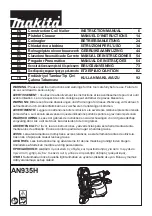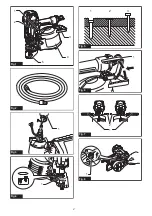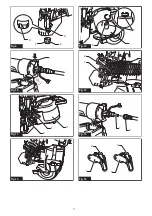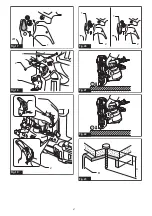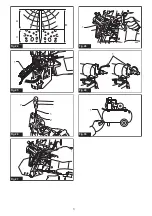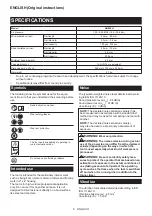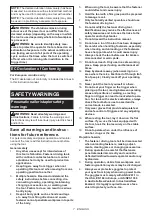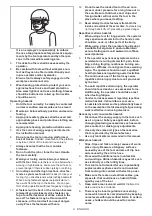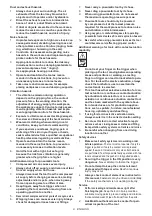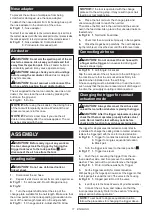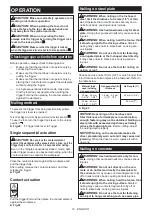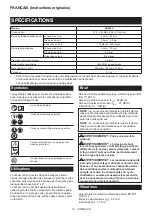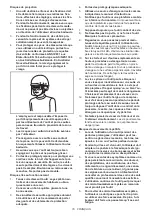
9 ENGLISH
Dust and exhaust hazards
1.
Always check your surroundings. The air
exhausted from the tool may blow dust or
objects and hit operator and/or bystanders.
2.
Direct the exhaust so as to minimize distur-
bance of dust in a dust filled environment.
3.
If dust or objects are emitted in the work area,
reduce the emission as much as possible to
reduce the health hazards and risk of injury.
Noise hazards
1.
Unprotected exposure to high noise levels can
cause permanent, disabling, hearing loss and
other problems such as tinnitus (ringing, buzz-
ing, whistling or humming in the ears).
2.
Conduct a risk assessment regarding noise
hazards in the work area and implement appro-
priate controls for these hazards.
3.
Appropriate controls to reduce the risk may
include actions such as damping materials to
prevent workpieces from "ringing".
4.
Use appropriate hearing protection.
5.
Operate and maintain the tool as recom-
mended in these instructions, to prevent an
unnecessary increase in noise levels.
6.
Take noise reduction measures, for example
placing workpieces on sound damping supports.
Vibration hazards
1.
The vibration emission during operation
depends on the gripping force, the contact
pressure force, the working direction, the
adjustment of energy supply, the workpiece,
the workpiece support. Conduct a risk assess-
ment regarding vibration hazards and imple-
ment appropriate controls for these hazards.
2.
Exposure to vibration can cause disabling damage to
the nerves and blood supply of the hands and arms.
3.
Wear warm clothing when working in cold
conditions, keep your hands warm and dry.
4.
If you experience numbness, tingling, pain or
whitening of the skin in your fingers or hands,
seek medical advice from a qualified occupational
health professional regarding overall activities.
5.
Operate and maintain the tool as recom-
mended in these instructions, to prevent an
unnecessary increase in vibration levels.
6.
Hold the tool with a light, but safe, grip
because the risk from vibration is generally
greater when the grip force is higher.
Additional warnings for pneumatic tools
1.
Compressed air can cause severe injury.
2.
Always shut off air supply, and disconnect tool
from air supply when not in use.
3.
Always disconnect the tool from the compressed
air supply before changing accessories, making
adjustments and/or repairs, when moving away
from an operating area to a different area.
4.
Keep fingers away from trigger when not
operating the tool and when moving from one
operating position to another.
5.
Never direct compressed air at yourself or anyone else.
6.
Whipping hoses can cause severe injury. Always
check for damaged or loose hoses or fittings.
7.
Never carry a pneumatic tool by its hose.
8.
Never drag a pneumatic tool by its hose.
9.
When using pneumatic tools, do not exceed
the maximum operating pressure ps max.
10.
Pneumatic tools should only be powered
by compressed air at the lowest pressure
required for the work process to reduce noise
and vibration, and minimize wear.
11.
Using oxygen or combustible gases for operating
pneumatic tools creates a fire and explosion hazard.
12.
Be careful when using pneumatic tools as the tool
could become cold, affecting grip and control.
Additional warnings for tools with contact actuation
capability
1.
Do not rest your finger on the trigger when
picking up the tool, moving between operating
areas and positions or walking, as resting
finger on trigger can lead to inadvertent opera
-
tion. For tools with selective actuation, always
check the tool before use to ascertain the
correct mode is selected.
2.
This tool has either selective actuation for con-
tact actuation or continuous contact actuation
by actuation mode selectors or is a contact
actuation or continuous actuation contact tool
and has been marked with the symbol above.
Its intended uses are for production applica-
tions such as pallets, furniture, manufactured
housing, upholstery and sheathing.
3.
If using this tool in selective actuation mode,
always ensure it is in the correct actuation setting.
4.
Do not use this tool in contact actuation for appli-
cations such as closing boxes or crates and fitting
transportation safety systems on trailers and lorries.
5.
Be careful when changing from one driving
location to another.
Safety devices
1.
Make sure all safety systems are in working order
before operation.
The tool must not operate if only the
trigger is pulled or if only the contact arm is pressed
against the wood. It must work only when both actions
are performed. Test for possible faulty operation with fas-
teners unloaded and the pusher in fully pulled position.
2.
Securing the trigger in the ON position is very
dangerous.
Never attempt to fasten the trigger.
3.
Do not attempt to keep the contact element
depressed with tape or wire.
Death or serious
injury may occur.
4.
Always check contact element as instructed in
this manual.
Fasteners may be driven accidentally
if the safety mechanism is not working correctly.
Service
1.
Perform cleaning and maintenance right after
finishing the job.
Keep the tool in tip-top condition.
Lubricate moving parts to prevent rusting and minimize
friction-related wear. Wipe off all dust from the parts.
2.
Ask Makita authorized service center for peri-
odical inspection of the tool.

